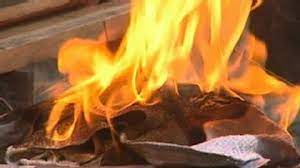
Fire Damage Threat
As we get into the summer season, outdoor home improvement activities start to increase. Some home improvement projects include outdoor staining of decks or furniture. These can be dangerous tasks if the rags used to stain these items are not properly disposed of. In the past year, Burke ER has already been called to cleanup two large home fires that were the result of oil-soaked rags spontaneously combusting.
The most common type of spontaneous combustion fires are those caused by improperly disposing of oil and stain soaked rags. Examples of these products are oil-based paints, teak, linseed oils, varnishes, polyurethane, paint thinners etc. Spontaneous combustion of oily rags occur when rags or cloth is slowly heated to its ignition point through oxidation.
A substance will begin to release heat as it oxidizes. If this heat has no way to escape, like in a pile, the temperature will rise to a level high enough to ignite the oil and ignite the rag or cloth. The fire from this can spread quickly to other combustibles and cause significant damage to your home or property.
Prevention of spontaneous combustion fires begins with good housekeeping. A clean work area can prevent a fire from spreading and getting bigger by not allowing the fire fuel to burn. Also understanding the potential for self-heating of rags soiled with oils such as linseed oil and turpentine is a key step in eliminating these preventable fires.
To properly and safely dispose of oily rags, use a metal container with a tight-fitting lid. Place soiled and used rags inside and then fill the rest of the way with water, seal the top and do not open it. This will prevent the oils from oxidizing, thus keeping the rags from heating up and igniting.
Contact your local garbage disposal company for their policy on disposal of the can and contents. Also, contact the town for the Hazardous Waste Collection schedule to dispose of any harmful chemicals or soaked rags.
The Right Way to Dispose of Paint Rags
Do not pile or ball rags soaked with oil paint into a tight mass or toss them in the regular trash while they’re still wet.
Do allow the rags to dry thoroughly before disposal. Spread the rags outdoors, on the ground or on a metal rack, until completely dry and somewhat hard. Two full days is usually enough time, but it might take longer.
Once the rags are completely dry, they should be safe for disposal. Put them in the trash on collection day. This method allows the oil to fully cure without overheating.
If paint rags catch fire outside, extinguish the fire by dousing with water or covering with sand or dirt. Don’t disturb them until you’re sure the fire is out.
If paint rags catch fire indoors, call the fire department, get everyone outside, then (and only then) try to put the fire out with an extinguisher. If you cannot put out the fire, get out of the house and wait for the fire department.
Don’t try to put out the fire with an extinguisher unless you know how to operate it.
